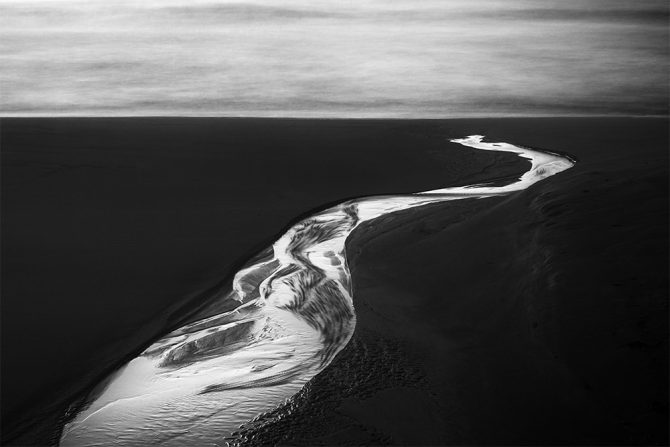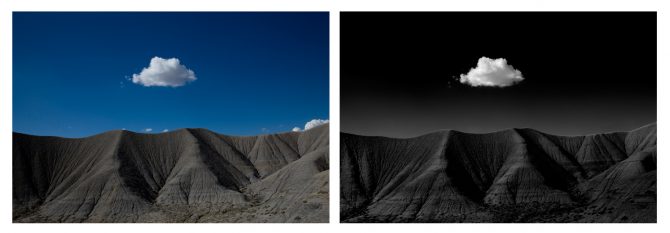October 20, 2012
I Am a Digital Black and White Photographer, Photographing in Color

Many people assume that I’m working in film and others are surprised to learn that I photograph in color. Let me explain.
All of the work you see on my website (with the exception of the 1970’s portfolio) was created digitally. I switched to digital in 2004 after working 35 years in the darkroom. And I’ll be honest, while I have fond memories of those darkroom days, I do not miss them and I would not go back.
Why? Because my work is better since I began using digital.
I’ve often heard the assumption that digital is suitable for color but not for black and white. That has not been my experience. I’ll use whatever tools give me the results I’m looking for and I have absolutely no allegiance to the process; film is not sacred, digital is not sacred, old processes are not sacred…the only thing that is sacred to me is the image.
Perhaps more surprising to some is that I shoot all of my images in color. I’ve written that I shoot in B&W mode and so you might wonder how can that be? Shooting in B&W mode allows me to see the camera’s preview image in black and white, but I save my files in RAW which means they are really in color.
Confusing? When you shoot in RAW all of those settings such as B&W mode, sharpness, saturation, toning, color balance…are not recorded in the image. RAW means just that, it’s a raw capture without any of those tweaks and the image is recorded in color.
This is a wonderful thing! This combination of B&W mode and RAW allows me to preview the image in black and white but process from the color image. Why do that? Because I don’t want my camera or software to decide how my images should look in black and white, the black and white processing is what makes my images “mine!”
Sometimes I’ll show people the “before” color photograph to illustrate how my vision and processing has changed the image.

My vision drives my processing and I’ll happily use whatever tools and processes best helps me do that.
Cole

wicked. this has been open in my browser for a while- I love when you forget that you have images open and they pop up to see them fresh again. It’s really something else to see how mundane the color straight raw’s are, the second one though with it’s pastel low contrast is a nice color feel however. Nonetheless, loving your before and afters, very interesting to see an artists approach to vision- I can’t help but wonder how you dealt with the vignetted seascape to stretch the corners- did you content aware fill, manual lens distortion attenuations, or am I just overthinking it and missing a crop? Whatever. Have a good one Mr Cole!
I was happily reading along, agreeing with all you were saying, since my “plan of attack” is similar to yours.
Then, I came across this… “I’ve often heard the assumption that digital is suitable for color but not for black and white.”
I too, have heard this refrain. Personally I think that assumption is utterly ridiculous, bordering on asinine!
Like you, I have decades of darkroom experience, both in color and BW. Wouldn’t trade that for anything… except… a computer and Photoshop! The ability to infinitely adjust an image is astounding. This applies to ANY image, color or BW.
To say digital post-production has limited abilities in its application to a BW image is just plain silly, but, people say it anyway. I can only guess, they’re inferring that the results fall short of traditional BW wet processes. Perhaps the images they refer to, do fall short, but I would argue that the BW images they’ve seen haven’t been executed very well.
In the hands of the knowledgeable and skilled ANY image, color or BW, can be digitally crafted to an extraordinary level.
To say, digital is only suitable for color, is a disservice to those of us that use digitals abilities in BW… or… as Sheldon from the “Big Bang Theory” would say, “…that’s a bunch of HOKUM”.
Thanks for sharing those before and after, I remember the first time I opened my first raw images, I thought, ” these look rubbish”……. Then I leaned the art of processing but I am still amazed evey time I look at before and after. Thanks to so many tips you shared with me, my processing has improved and keeps improving……
So much reality and truth in your message and in these added comments. It’s about the final artwork… and how you got there is just an interesting adventure through learning, experience, tools and technique. It is what it is when you are done!
Great post Cole. In a word, liberating!
Yes, it does take a lot of faith sometimes to see the potential in a RAW file! Some of that faith comes from vision, knowing how you want it to look. Some of the faith comes from your confidence in your ability to convert an image. And sometimes you just have hope, hope that you can find a way to make the image how you envision it.
Necessity is the mother of invention.
Cole
What an auspicious happening it is that you should post on this topic at the very time I have been considering the same path. I have been split on where to put my limited dollars, wrestling with the choice of working more with large format film as an art form or putting the cash into solidifying digital as my art medium. I think I have been long influenced to believe that I need to work more with film to be taken seriously as an artist. Thank you, Cole, for helping to turn this thinking around. While I would process my own film, I ultimately have no intention to buy an enlarger or stock a full darkroom, so it will still just end up as pixels in the end. That’s money better spent on lenses and eventually a fine printer, I think. Hell, I know!
“The only thing that is sacred to me is the image.” I love it. Cole, your dedication and insight into your vision, as well as your process are impressive. You continually amaze me. And, though I’m a color girl myself, I would definitely go B&W if I thought I could make them look half as good as you do. 🙂
“My vision drives my processing and I’ll happily use whatever tools and processes best helps me do that.” Love that, Cole. So true, when all is said and done, it’s the vision that matters, not the path.
I’ll add this in favor of digital technology and also to perhaps alleviate concerns that digital photography isn’t taken seriously.
My son, an accomplished photographer, attended Rochester Institute of Technology on a full photography scholarship. As I’m sure many of you are aware, RIT’s photography department is primarily funded by KODAK and is considered one of the nation’s premier photographic education programs.
His class was taught every aspect of photography, both digital and analog. Traditional wet processing was taught in conjunction with present day computer post-production, in a well rounded approach.
His class was the last to receive such an approach. The department determined that they’re students would be better served by a more concentrated education in digital photographic technologies. Traditional processing techniques are still taught… as electives.
I’m certainly not looking to offend anyone’s fine art sensibilities, as it can easily be pointed out that, RIT is not considered a fine art institution. However, their decision to go primarily in a digital direction is definitely noteworthy. Especially, when you consider that their decision was made more than 7 years ago.
As Cole and many of you have pointed out, it matters little how you get there… only that once you’ve arrived, you’ve made it worth the trip.
Jack Dykinga has famously referred to cameras and technology as hammers. They’re just tools and one isn’t necessarily better than any other.
One advantage I find with raw captures, and all the color info in the image, is that after I have converted to b&w, I can go in and use things like selective color to move the tones in different directions.
Hey Cole, thanks so much for posting this. It’s a rare treat to see your unedited, “before” images and to hear a little of your philosophy behind editing, shooting film vs digital, etc. Thanks again!
Cole,
Thank you for sharing. B&W mode in RAW…that’s a great concept. While I always shoot in RAW, I’ve never considered a B&W mode. Honestly, I’m not sure my camera has that setting. But it will be the first thing I check when I get back home next week.
Hi Cole, I used to love spending time in my little garden shed that I built specifically for a darkroom at the bottom of my parents house. There are some things that I miss about it, maybe I should hang a safelight above my monitor? I do know that for me, I find digital far easier to produce monochrome images than the old way. Here is a before and after rollover image should you be interested.
http://www.shoalhavenlife.com/pomgonewalkabout/before_and_after.html
This is very very interesting, thanks for sharing!
Manny has been creating and remixing dance music that has
been recorded by some of the hottest artists, in the music industry today, for over 10 years.
By promoting creations online, that were created with the software’s soundscape tools, amateur musicians will climb the ladder toward professionalism.